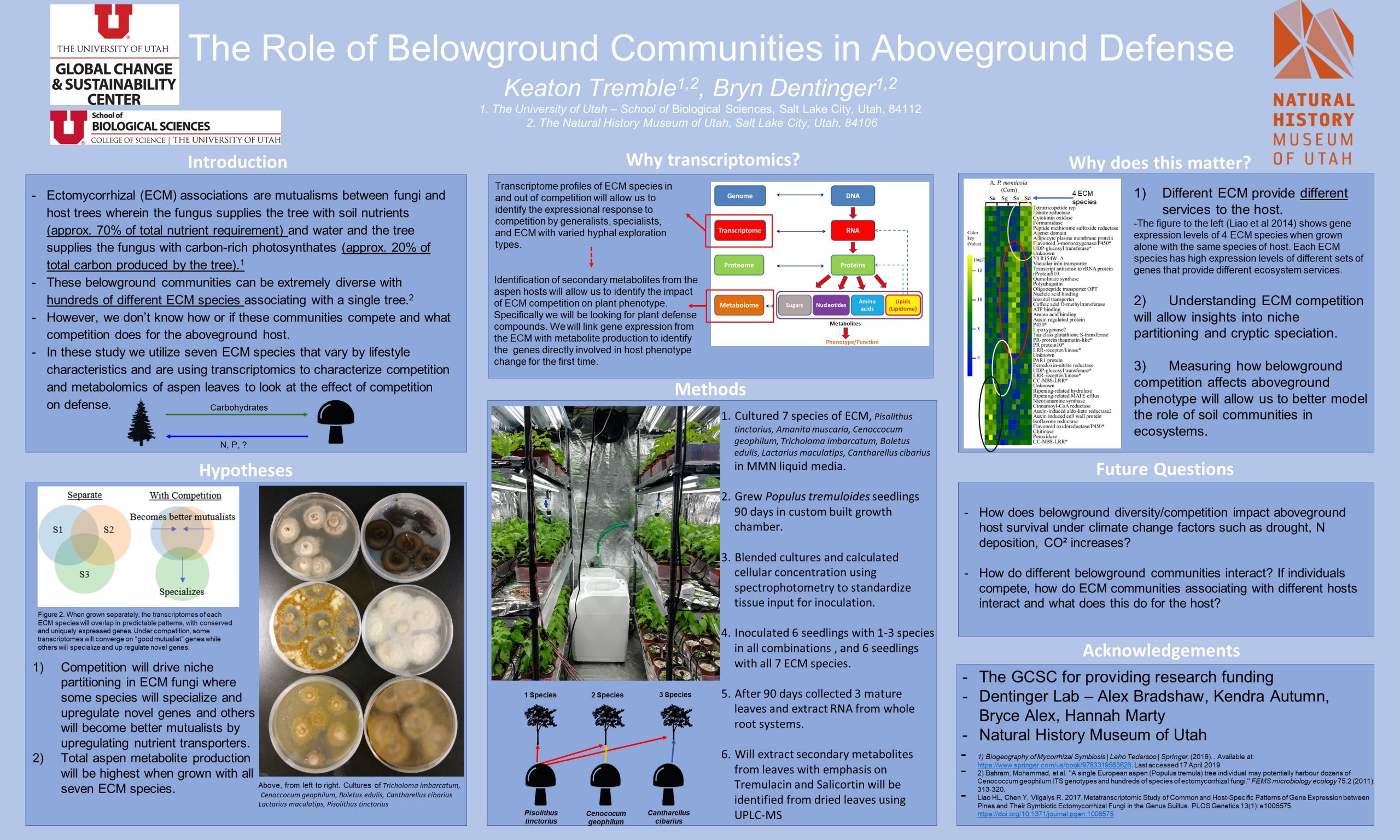Impact of ectomycorrhizal fungal diversity on aspen gene regulation
-Keaton Tremble, Bryn Dentinger
[bs_collapse id=”collapse_849f-c6bb”]
[bs_citem title=”Bio” id=”citem_4b55-7b9d” parent=”collapse_849f-c6bb”]
Hi there! I came out to Utah 5 years ago after finishing my undergrad at Carleton College in Minnesota to be a ski and climb bum for a year before grad school. As most people do, I ended up falling in love with Utah and once I got in touch with the Dentinger Lab I knew this was a dream place to get my PhD. When I’m not skiing/picking up a new outdoor hobby every season, I focus my research on the interaction of ecology and evolution in fungal ectomycorrhizal (ECM) communities. In short, I study the process of speciation and diversification in ECM fungi in order to get a better grasp on ECM ecology and behavior. Without understanding the individual behavior of any one ECM species it is impossible to understand this relationship between ECM and trees.[/bs_citem]
[bs_citem title=”Abstract” id=”citem_a78f-2667″ parent=”collapse_849f-c6bb”]
The mutualism between temperate trees and ectomycorrhizal fungi (ECM) dominates much of the northern hemisphere. This association provides numerous benefits for the tree host such as nitrogen acquisition, drought tolerance, and defense. ECM soil communities are highly diverse, and hundreds of species may colonize a single host. However, it is unknown how individuals in these complex communities interact, and how interactions my impact the host. We are conducting a novel metatranscriptomic assay that will identify the role of belowground competition in gene expression of ECM fungi. We hypothesize that competition will have an additive effect on gene expression, where distantly related ECM further up-regulate genes associated with nutrient acquisition and transport to become better mutualists, while closely related ECM shift expression patters to avoid niche competition. This study may lead to insights on the role ECM community composition on host behavior, which may help combat detrimental effects of climate change.[/bs_citem]
[bs_citem title=”Narrative” id=”citem_e63e-b414″ parent=”collapse_849f-c6bb”]
Over 60% of all tree stems on earth have a mutualistic relationship with fungi in the soil that provide most of the nutrients a tree needs to live. This is a obligate relationship, which means the tree cannot survive without the fungi and the fungi cannot survive without the tree. However, this can be a very complex relationship because dozens to hundreds of fungi can associate with a single tree. In the face of climate change it is important to look below the soil to understand how impacts to belowground communities impact the host above.
This study is trying to understand how different species of mutualistic fungi interact with each other and compete, and how these interactions will impact the tree above. To do this we are growing Aspen seedlings and inoculating them with 1-4 species of fungi. After growing, we are then extracting RNA from the soil to see which genes are used by the fungi when they are alone and which genes are used when they are competing with another fungus. This will allow us to identify changes in behavior brought about by the introduction of a competitor. We will then associate these changes with the production of defense compounds in the host’s leaves.
This study will allow us to identify how fungal community interactions will impact the host, giving us a greater ability to predict how changes to fungal community due to climate change will impact overall forest health.
[/bs_citem]
[/bs_collapse]

